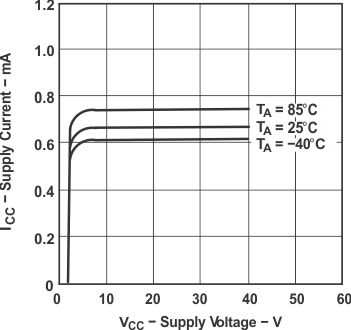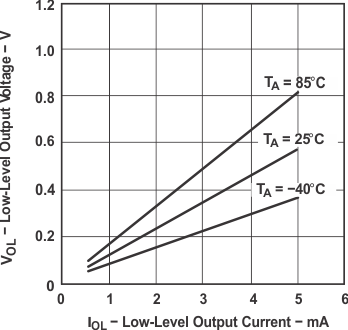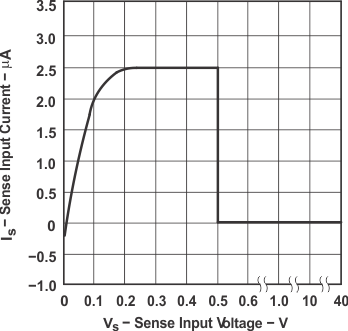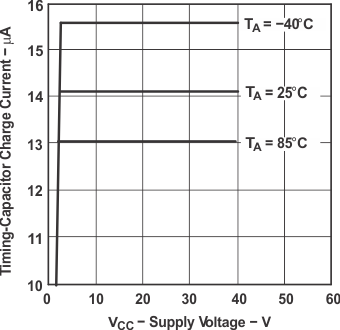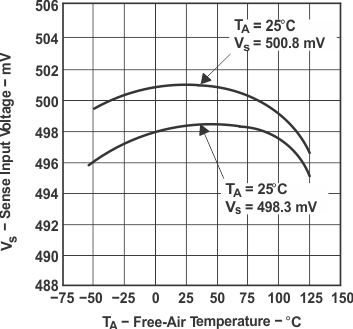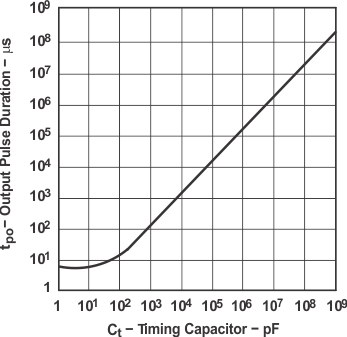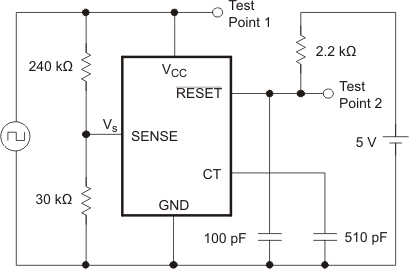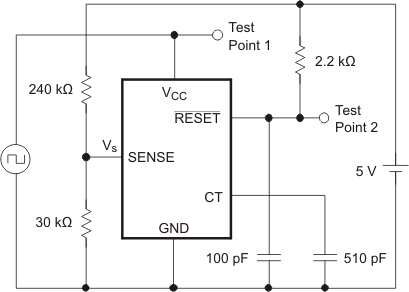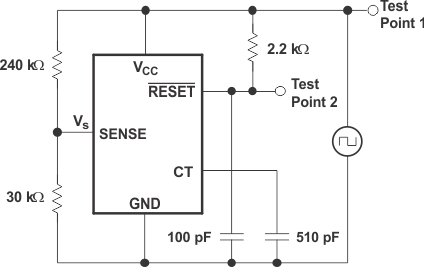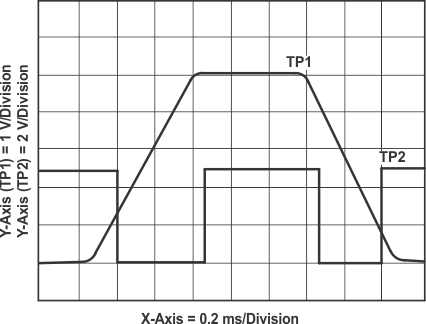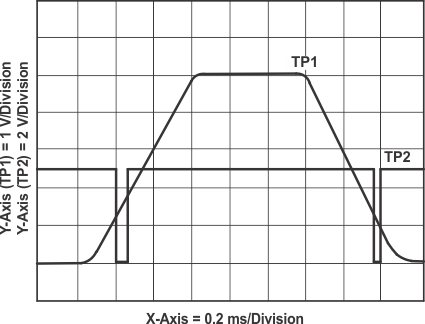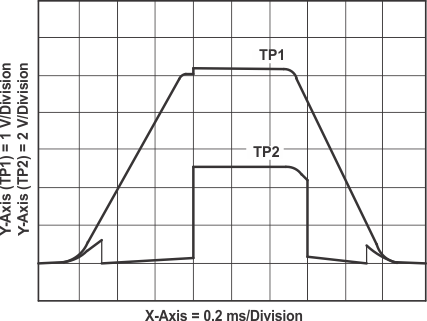SLVS220G July 1999 – August 2016 TL7700
PRODUCTION DATA.
- 1 Features
- 2 Applications
- 3 Description
- 4 Revision History
- 5 Pin Configuration and Functions
- 6 Specifications
- 7 Parameter Measurement Information
- 8 Detailed Description
- 9 Application and Implementation
- 10Power Supply Recommendations
- 11Layout
- 12Device and Documentation Support
- 13Mechanical, Packaging, and Orderable Information
パッケージ・オプション
メカニカル・データ(パッケージ|ピン)
サーマルパッド・メカニカル・データ
- PS|8
発注情報
6 Specifications
6.1 Absolute Maximum Ratings
over operating free-air temperature range (unless otherwise noted)(1)| MIN | MAX | UNIT | |||
|---|---|---|---|---|---|
| VCC | Supply voltage(2) | 41 | V | ||
| Vs | Sense input voltage | –0.3 | 41 | V | |
| VOH | Output voltage (off state) | 41 | V | ||
| IOL | Output current (on state) | 5 | mA | ||
| TJ | Operating virtual-junction temperature | 150 | °C | ||
| Tstg | Storage temperature | –65 | 150 | °C | |
(1) Stresses beyond those listed under Absolute Maximum Ratings may cause permanent damage to the device. These are stress ratings only, which do not imply functional operation of the device at these or any other conditions beyond those indicated under Recommended Operating Conditions. Exposure to absolute-maximum-rated conditions for extended periods may affect device reliability.
(2) All voltage values are with respect to the network ground terminal.
6.2 ESD Ratings
| VALUE | UNIT | |||
|---|---|---|---|---|
| V(ESD) | Electrostatic discharge | Human-body model (HBM), per ANSI/ESDA/JEDEC JS-001(1) | 500 | V |
| Charged-device model (CDM), per JEDEC specification JESD22-C101(2) | 1000 | |||
(1) JEDEC document JEP155 states that 500-V HBM allows safe manufacturing with a standard ESD control process.
(2) JEDEC document JEP157 states that 250-V CDM allows safe manufacturing with a standard ESD control process.
6.3 Recommended Operating Conditions
| MIN | MAX | UNIT | ||
|---|---|---|---|---|
| VCC | Supply voltage | 1.8 | 40 | V |
| IOL | Low-level output current | 3 | mA | |
| TA | Operating free-air temperature | –40 | 85 | °C |
6.4 Thermal Information
| THERMAL METRIC(1) | TL7700 | UNIT | ||||
|---|---|---|---|---|---|---|
| DGK (VSSOP) |
P (PDIP) |
PS (SO) |
PW (TSSOP) |
|||
| 8 PINS | 8 PINS | 8 PINS | 8 PINS | |||
| RθJA | Junction-to-ambient thermal resistance | 173.8 | 57.6 | 112.5 | 172.9 | °C/W |
| RθJC(top) | Junction-to-case (top) thermal resistance | 63.1 | 47.4 | 64.2 | 56.6 | °C/W |
| RθJB | Junction-to-board thermal resistance | 93.9 | 34.7 | 61.6 | 101.2 | °C/W |
| ψJT | Junction-to-top characterization parameter | 8.5 | 25 | 25.1 | 5.2 | °C/W |
| ψJB | Junction-to-board characterization parameter | 92.5 | 34.6 | 60.7 | 99.6 | °C/W |
(1) For more information about traditional and new thermal metrics, see the Semiconductor and IC Package Thermal Metrics application report.
6.5 Electrical Characteristics
VCC = 3 V (unless otherwise noted)| PARAMETER | TEST CONDITIONS | TA | MIN | TYP | MAX | UNIT | |
|---|---|---|---|---|---|---|---|
| Vs | SENSE input voltage | 25°C | 495 | 500 | 505 | mV | |
| –40°C to 85°C | 490 | 510 | |||||
| Is | SENSE input current | Vs = 0.4 V | 25°C | 2 | 2.5 | 3 | µA |
| –40°C to 85°C | 1.5 | 3.5 | |||||
| ICC | Supply current | VCC = 40 V, Vs = 0.6 V, No load | 25°C | 0.6 | 1 | mA | |
| VOL | Low-level output voltage | IOL = 1.5 mA | 25°C | 0.4 | V | ||
| IOL = 3 mA | 25°C | 0.8 | |||||
| IOH | High-level output current | VOH = 40 V, Vs = 0.6 V | –40°C to 85°C | 1 | µA | ||
| ICT | Timing-capacitor charge current | Vs = 0.6 V | 25°C | 11 | 15 | 19 | µA |
6.6 Switching Characteristics
VCC = 3 V, TA = 25°C (unless otherwise noted)| PARAMETER | TEST CONDITIONS | MIN | TYP | MAX | UNIT | |
|---|---|---|---|---|---|---|
| tpi | SENSE pulse duration | CT = 0.01 µF (See Figure 17) | 2 | µs | ||
| tpo | Output pulse duration | CT = 0.01 µF (See Figure 17) | 0.5 | 1 | 1.5 | ms |
| tr | Output rise time | CT = 0.01 µF, RL = 2.2 kΩ, CL = 100 pF (See Figure 17) | 15 | µs | ||
| tf | Output fall time | CT = 0.01 µF, RL = 2.2 kΩ, CL = 100 pF (See Figure 17) | 0.5 | µs | ||
| tpd | Propagation delay time, SENSE to output | CT = 0.01 µF (See Figure 17) | 10 | µs | ||
6.7 Typical Characteristics
Data at high and low temperatures are applicable only within the recommended operating conditions.